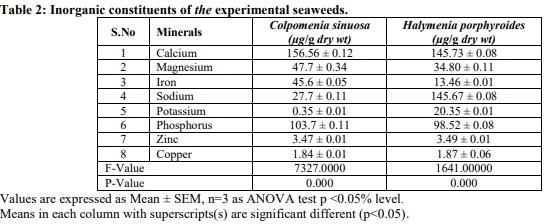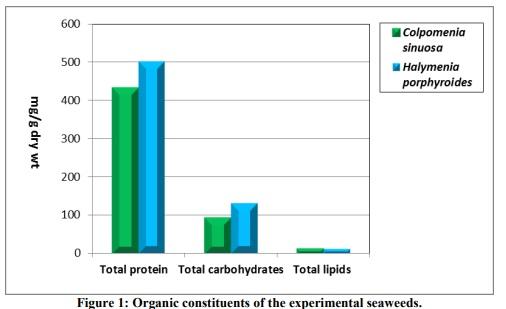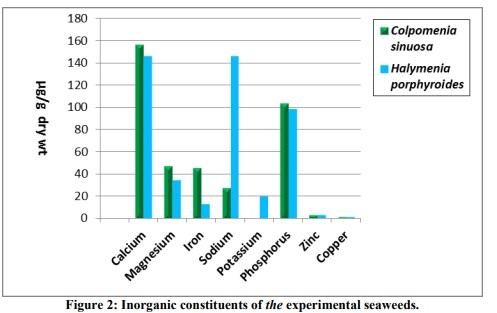Biochemical Investigation of Marine Seaweeds Colpomenia Sinuosa and Halymenia Poryphyroides Collected along The South East Coast of Tamilnadu, India
In the current study, the biochemical evaluation of the seaweeds were conducted which were collected along the south east coast of India. The marine brown macro alga Colpomenia sinuosa (Mertens ex Roth) Derbes and Solier as well as the marine red alga Halymenia poryphyroides Boergesen were used in this study. The relationship between the nutritive components and the variation of the biochemical composition like organic and inorganic constituents were mainly analyzed in the current study. The present analysis revealed that both the seaweeds were rich in protein content whereas more carbohydrate content was observed in marine red alga Halymenia porphyroides compared to the marine brown alga Colpomenia sinuosa. Similarly, the analysis of inorganic biochemical constituents revealed that calcium, magnesium, iron and phosphorus were present in higher amount in marine brown alga Colpomenia sinuosa whereas sodium and potassium contents were observed in higher amount in marine red alga Halymenia porphyroides. The presence of high organic and inorganic biochemical constituents in these seaweeds may be of economic importance and ass potential health food for human diets.
KEYWORDS: Biochemical composition, Colpomenia Sinuosa, Halymenia porphyroides.




1. Mishra VK, Temelli PF, Ooraikul Shacklock and
Craigie JS. 1993. Lipids of the red algae, Palmaria palmate. Botanica Marina, 1993; 6(2): 169-174.
2. Ajit KA, Meena K, Rao MM, Panda P, Mangal AK,
Reddy G and Ramesh Babu. Marine algae: An
Introduction, Food value and Medicinal uses.
Journal of Pharmacy Research, 2011; 4(1): 123-127.
3. Smit AJ. Medicinal and pharmaceutical uses of seaweed natural products: A review. Journal of
Applied Phycology, 2004; 16: 245–262.
4. Wong KH and Cheung PCK. Nutritional evaluation of some subtropical red and green seaweed. Part Iproximate composition, amino acid profiles and some physico-chemical properties. Food Chemistry,
2000; 71: 475-482.
5. Norziah MH and Ching Ch Y. Nutritional composition of edible seaweeds Gracilaria changgi.
Food Chemistry, 2002; 68: 69-76
6. Sanchez-Machado DI, Lopez-Hernandez J and
Paseiro-Losada P. High-performance liquid chromatographic determination of “α-tocopherol” in macro algae. Chromatography A, 2002; 976:
277-284.
7. Ravi S, Baghel, Puja Kumari, Reddy, CRK and
Bhavanath Jha. Growth, pigments, and biochemical composition of marine red alga
Gracilaria crassa. Journal of Applied Phycology,
2014; 26(5): 2143–2150.
8. Dawes CJ, Kovach C and Friedlander M. Exposure of Gracilaria to various environmental conditions II.
The effect on fatty acid composition. Botanica
Marina, 1993; 36: 289-296.
9. Koehler S and Kennish R. Summer and winter comparisons in the nutritional value of marine macro algae from Hong Kong. Botanica Marina,
1996; 39: 11-17.
10. Sokolova EV, Barabanova AO, Homenko VA,
Soloveva TF, Bogdanovich RN and Yermak IM. In vitro and ex vivo studies of antioxidant activity of carrageenans, sulfated polysaccharides from red algae. Bull Exp Biol Me, 2011; 150: 426-428.
11. Ibanez E, Herrero M, Mendiola JA and castroPuyana M. Extraction and Characterization of
Bioactive Compounds with Health Benefits from
Marine Resources: Macro and Micro Algae,
Cyanobacteria, and Invertebrates. In Marine Bioact
Compounds; Haves, M., Ed.; Springer-Verlag New
York Inc.: New York, NY, USA, 2012; 55–98.
12. Ito K and Hori K. Seaweed: Chemical composition and potential uses. Food Review International, 1980;
5: 101-144.
13. Fujiwara-Arasaki T, Mino N and Kuroda M. The protein value in human nutrition of edible marine algae in Japan, Hydrobiologia, 1984; 116/117:
513-516.
14. Nisizawa K, Noda H, Kikuchi R and Watanabe T,
The main seaweed food in Japan, Hydrobilologia,
1987; 151/152: 5-29.
15. Lee RE. Phycology, 2nd edn. Cambridge: Cambridge
University Press, 1989.
16. Blunt JW, Copp BR, Munro MHG, Northcote PT and Prinsep MR. Marine natural products. Nat. Prod.
Rep., 2011; 28: 196-268.
17. Zemke-White WL and Ohno M. World seaweed utilization: An end-of century summary. Journal of
Applied Phycology, 1999; 11: 369-376.
18. Jensen A. Present and Future Needs for Alga and
Algal Products. Hydrobiologia, 1993; 260/261: 5-21.
19. Fleurence J. Seaweed proteins: biochemical, nutritional aspects and potential uses, Trends in
Food Sci. & Technol, 1999; 10: 25-28.
20. Sadasivam S and Manickam A. Biochemical method for agriculture science, Willey, Eastern Ltd., 105,
1992.
21. Lowry OH, Rosebrough NJ and Randell RJ. Protein measurement with the Folin phenol reagent, J. Biol.
Chem, 1951; 193: 265-275
22. Bligh EG and Dyer WJ. A rapid method of total lipid extraction and purification. Can. J. Biochem.
Physiol, 1959; 37: 911-917.
23. AOAC, Official Methods of Analysis, 15th Ed.,
Association of Official Analytical Chemists,
Washington, DC, 1990.
24. Bhuvaneshwari and Murugesan. Biochemical composition of seaweeds along south east coast of tamilnadu, India. International journal of biology, pharmacy and allied sciences, 2013; 2(7):
1430-1436.
25. Dere S, Dalkiran N, Glu DK, Yildiz G and Dere E.
The determination of total protein, total soluble carbohydrate and pigment contents of some macroalgae collected from Gemlik-Karacaali (Bursa) and Erdek- Ormanli (Balikesir) in the Sea of
Marmara, Turkey, Oceanologia, 2003; 45(3):
453-471.
26. Fleurence J. Seaweed proteins, biochemical, nutritional aspects and potential uses. Trends in
Food Sci. and Nutri, 1999; 44: 23-35.
27. Dhargalkar VK. Biochemical studies on Ulva reticulata Forsskal, Proc. Int. Symp, Marine algae of
Indian Ocean region, CSMCRI, Bhavnagar, 40.
1979.
28. Nisizawa K, Noda H, Kikuchi R and Watanabe T.
The main seaweeds in Japan, Hydrobiologia, 1997;
151/152(5): 29.
29. Yoshie Y, Suzuki T, Shirai T and Hirano T, Changes in the contents of dietary fibers, minerals, free amino acids and fatty acids during processing of dried nori,
Nippon Suisan Gakkaishi, 1994; 60: 117-123.
30. Fleurence J and Le Coeur C. Influence of mineralization methods on the determination of the mineral content of brown seaweed Undaria pinnatifida by atomic absorption spectrophotometry,
Hydrobiologia, 1993; 260/261: 531-534.







